Object-Oriented Clustering Approach to Detect Evolutions of ENSO-Related Precipitation Anomalies over Tropical Pacific Using Remote Sensing Products
Abstract
1. Introduction
2. Materials and Methods
2.1. Materials
2.1.1. Simulated Raster Dataset
2.1.2. Remote Sensing Products
2.2. Methods
- Spatial Neighborhood: The spatial neighborhood of a pixel is the other eight surrounding pixels.
- Core Pixel: For a pixel p, if the number of neighboring pixels with attribute distance from p less than Kth is fewer than K in p’s spatial neighborhood, then p is the core pixel.
- Reachable Pixel: A pixel is considered reachable for a cluster when the difference between its attribute and the average attribute of the cluster does not exceed Kth.
- Isolated Pixel: Isolated pixels are reachable pixels situated at the corners of the spatial neighborhood that are not adjacent to other reachable pixels.
- Merge: Multiple snapshot objects at a given timestamp are overlapping with and similar to a snapshot object from the subsequent timestamp.
- Split: Multiple snapshot objects at a given timestamp are overlapping with and similar to a snapshot object from the previous timestamp.
2.2.1. Snapshot Object Extraction
| Algorithm 1. Snapshot Object Extraction. |
| Step1: Scan all pixels and collect core pixels into a list L. Step2: Sort core pixels in list L in descending order based on the distance between pixel attribute and global attribute averages. Step3: Select an unprocessed core pixel from L to initialize a new cluster and add the pixel to an empty queue Q of the cluster. Step4: Pop a core pixel from Q, expand the cluster by incorporating reachable, non-isolated, and unprocessed pixels in spatial neighborhood of the core pixel, and add the new pixels to Q that are also core pixels. Step5: If Q is not empty, repeat step 4 to expand the cluster. Otherwise, jump to step 3 until all core pixels in L have been processed. |
2.2.2. Snapshot Object Clustering
| Algorithm 2. Snapshot Object Clustering. |
| For t in all timestamps For o in t.Snapshot_Objects Prev = similar snapshot objects of o at t−1 timestamp If not the elements of Prev all belong to the same cluster Then Merge different clusters of elements to single cluster Assign o to the cluster of Prev. |
2.2.3. Parameter Setting
2.2.4. Complexity
3. Results
3.1. Experiments on Simulated Dataset
3.2. Case Study of Precipitation Anomalies over the Pacific Ocean
4. Discussion
4.1. OSCAR Parameters Setting
4.2. Quantitative Comparison between OSCAR and DcSTCA
4.3. Qualitative Comparison between OSCAR and DcSTCA
4.4. Relationship between Precipitation Anomalies Clusters and ENSO
5. Conclusions
Author Contributions
Funding
Data Availability Statement
Conflicts of Interest
References
- Neelin, J.D.; Battisti, D.S.; Hirst, A.C.; Jin, F.-F.; Wakata, Y.; Yamagata, T.; Zebiak, S.E. ENSO theory. J. Geophys. Res. 1998, 103, 14261–14290. [Google Scholar] [CrossRef]
- McPhaden, M.J.; Zebiak, S.E.; Glantz, M.H. ENSO as an integrating concept in earth science. Science 2006, 314, 1740–1745. [Google Scholar] [CrossRef] [PubMed]
- Deser, C.; Alexander, M.A.; Xie, S.-P.; Phillips, A.S. Sea Surface Temperature Variability: Patterns and Mechanisms. Annu. Rev. Mar. Sci. 2010, 2, 115–143. [Google Scholar] [CrossRef] [PubMed]
- Huang, P.; Xie, S.-P. Mechanisms of change in ENSO-induced tropical Pacific rainfall variability in a warming climate. Nat. Geosci. 2015, 8, 922–926. [Google Scholar] [CrossRef]
- Power, S.; Delage, F.; Chung, C.; Kociuba, G.; Keay, K. Robust twenty-first-century projections of El Niño and related precipitation variability. Nature 2013, 502, 541–545. [Google Scholar] [CrossRef]
- Cai, W.; Borlace, S.; Lengaigne, M.; van Rensch, P.; Collins, M.; Vecchi, G.; Timmermann, A.; Santoso, A.; McPhaden, M.J.; Wu, L.; et al. Increasing frequency of extreme El Niño events due to greenhouse warming. Nat. Clim. Chang. 2014, 4, 111–116. [Google Scholar] [CrossRef]
- Alexander, M.A.; Bladé, I.; Newman, M.; Lanzante, J.R.; Lau, N.C.; Scott, J.D. The atmospheric bridge: The influence of ENSO teleconnections on air-sea interaction over the global oceans. J. Clim. 2002, 15, 2205–2231. [Google Scholar] [CrossRef]
- Yan, Z.; Wu, B.; Li, T.; Collins, M.; Clark, R.; Zhou, T.; Murphy, J.; Tan, G. Eastward shift and extension of ENSO-induced tropical precipitation anomalies under global warming. Sci. Adv. 2020, 6, eaax4177. [Google Scholar] [CrossRef]
- Yang, Y.; Park, J.; An, S.; Bin, W.; Xiao, L. Mean sea surface temperature changes influence ENSO-related precipitation changes in the mid-latitudes. Nat. Commun. 2021, 12, 1495. [Google Scholar] [CrossRef]
- Maes, C.; Belamari, S. On the impact of salinity barrier layer on the Pacific ocean mean state and ENSO. SOLA 2011, 7, 97–100. [Google Scholar] [CrossRef]
- Zhu, J.; Huang, B.; Zhang, R.-H.; Hu, Z.-Z.; Kumar, A.; Balmaseda, M.A.; Marx, L.; Kinter, J.L., III. Salinity anomaly as a trigger for ENSO events. Sci. Rep. 2014, 4, 6821. [Google Scholar] [CrossRef]
- Zhang, R.-H. A hybrid coupled model for the Pacific ocean-atmosphere system. Part I, description and basic performance. Adv. Atmos. Sci. 2015, 32, 301–318. [Google Scholar] [CrossRef]
- Kang, X.; Zhang, R.-H.; Wang, G. Effects of different freshwater flux representations in an ocean general circulation model of the tropical Pacific. Sci. Bull. 2017, 62, 345–351. [Google Scholar] [CrossRef]
- Gao, C.; Zhang, R.-H.; Karnauskas, K.B.; Zhang, L.; Tian, F. Separating freshwater flux effects on ENSO in a hybrid coupled model of the tropical Pacific. Clim. Dyn. 2020, 54, 4605–4626. [Google Scholar] [CrossRef]
- Zhi, H.; Zhang, R.-H.; Lin, P.; Yu, P.; Zhou, G.; Shi, S. Interannual salinity variability associated with the Central Pacific and Eastern Pacific El Niños in the tropical Pacific. J. Geophys. Res. 2020, 125, e2020JC016090. [Google Scholar] [CrossRef]
- Zhu, Y.; Zhang, R.-H. A deep learning–based U-Net model for ENSO-related precipitation responses to sea surface temperature anomalies over the tropical Pacific. Atmos. Ocean. Sci. Lett. 2023, 100351. [Google Scholar] [CrossRef]
- Yang, J.; Gong, P.; Fu, R.; Zhang, M.; Chen, J.; Liang, S.; Xu, B.; Shi, J.; Dickinson, R. The role of satellite remote sensing in climate change studies. Nat. Clim. Chang. 2013, 3, 875–883. [Google Scholar] [CrossRef]
- Pike, M.; Lintner, B.R. Application of Clustering Algorithms to TRMM Precipitation over the Tropical and South Pacific Ocean. J. Clim. 2020, 33, 5767–5785. [Google Scholar] [CrossRef]
- Wang, B.; Luo, X.; Liu, J. How Robust is the Asian Precipitation–ENSO Relationship during the Industrial Warming Period (1901–2017)? J. Clim. 2020, 33, 2779–2792. [Google Scholar] [CrossRef]
- Ma, T.; Chen, W.; Chen, S.; Garfinkel, C.I.; Ding, S.; Song, L.; Li, Z.; Tang, Y.; Huangfu, J.; Gong, H.; et al. Different ENSO Teleconnections over East Asia in Early and Late Winter: Role of Precipitation Anomalies in the Tropical Indian Ocean and Far Western Pacific. J. Clim. 2022, 35, 7919–7935. [Google Scholar] [CrossRef]
- Dixon, M.; Wiener, G.; Technology, O. TITAN: Thunderstorm Identification, Tracking, Analysis, and Nowcasting—A Radar-based Methodology. J. Atmos. Ocean. Technol. 1993, 10, 785–797. [Google Scholar] [CrossRef]
- Lakshmanan, V.; Hondl, K.; Rabin, R. An Efficient, General-Purpose Technique for Identifying Storm Cells in Geospatial Images. J. Atmos. Ocean. Technol. 2009, 26, 523–537. [Google Scholar] [CrossRef]
- Muñoz, C.; Wang, L.-P.; Willems, P. Enhanced object-based tracking algorithm for convective rain storms and cells. Atmos. Res. 2018, 201, 144–158. [Google Scholar] [CrossRef]
- Han, L.; Fu, S.; Zhao, L.; Zheng, Y.; Wang, H.; Lin, Y. 3D Convective Storm Identification, Tracking, and Forecasting—An Enhanced TITAN Algorithm. J. Atmos. Ocean. Technol. 2009, 26, 719–732. [Google Scholar] [CrossRef]
- Liu, W.B.; Li, X.G.; Rahn, D.A. Storm event representation and analysis based on a directed spatiotemporal graph model. Int. J. Geogr. Inf. Sci. 2016, 30, 948–969. [Google Scholar] [CrossRef]
- Lu, E.; Zou, X.; Zhao, C.; Zhao, W.; Ye, D.; Zhang, Q. Temporal–Spatial Monitoring of an Extreme Precipitation Event, Determining Simultaneously the Time Period It Lasts and the Geographic Region It Affects. J. Clim. 2017, 30, 6123–6132. [Google Scholar] [CrossRef]
- Hou, J.; Wang, P. Tracking via Tree Structure Representation of Radar Data. J. Atmos. Ocean. Technol. 2017, 34, 729–747. [Google Scholar] [CrossRef]
- Xue, C.; Liu, J.; Yang, G.; Wu, C. A Process-Oriented Method for Tracking Rainstorms with a Time-Series of Raster Datasets. Appl. Sci. 2019, 9, 2468. [Google Scholar] [CrossRef]
- Liu, J.; Xue, C.; He, Y.; Dong, Q.; Kong, F.; Hong, Y. Dual-Constraint Spatiotemporal Clustering Approach for Exploring Marine Anomaly Patterns Using Remote Sensing Products. IEEE J. Sel. Top. Appl. Earth Obs. Remote Sens. 2018, 11, 3963–3976. [Google Scholar] [CrossRef]
- Li, L.; Xu, Y.; Xue, C.; Fu, Y.; Zhang, Y. A Process-Oriented Approach to Identify Evolutions of Sea Surface Temperature Anomalies with a Time-Series of a Raster Dataset. ISPRS Int. J. Geo-Inf. 2021, 10, 500. [Google Scholar] [CrossRef]
- Xue, C.; Xu, Y.; He, Y. A global process-oriented sea surface temperature anomaly dataset retrieved from remote sensing products. Big Earth Data 2022, 6, 179–195. [Google Scholar] [CrossRef]
- Wolter, K.; Timlin, M.S. Measuring the strength of ENSO events-how does 1997/98 rank? Weather 1998, 53, 315–324. [Google Scholar] [CrossRef]
- Schneider, T.; Bischoff, T.; Haug, G.H. Migrations and dynamics of the intertropical convergence zone. Nature 2014, 513, 45–53. [Google Scholar] [CrossRef]
- Pontes, G.M.; Taschetto, A.S.; Sen Gupta, A.; Santoso, A.; Wainer, I.; Haywood, A.M.; Chan, W.-L.; Abe-Ouchi, A.; Stepanek, C.; Lohmann, G.; et al. Mid-Pliocene El Niño/Southern Oscillation suppressed by Pacific intertropical convergence zone shift. Nat. Geosci. 2022, 15, 726–734. [Google Scholar] [CrossRef]
- Folland, C.K.; Renwick, J.A.; Salinger, M.J.; Mullan, A.B. Relative influences of the Interdecadal Pacific Oscillation and ENSO on the South Pacific Convergence Zone. Geophys. Res. Lett. 2002, 29, 21-1–21-4. [Google Scholar] [CrossRef]
- Zhang, R.-H.; Busalacchi, A.J. Freshwater flux (FWF)-induced oceanic feedback in a hybrid coupled model of the tropical Pacific. J. Clim. 2009, 22, 853–879. [Google Scholar] [CrossRef]

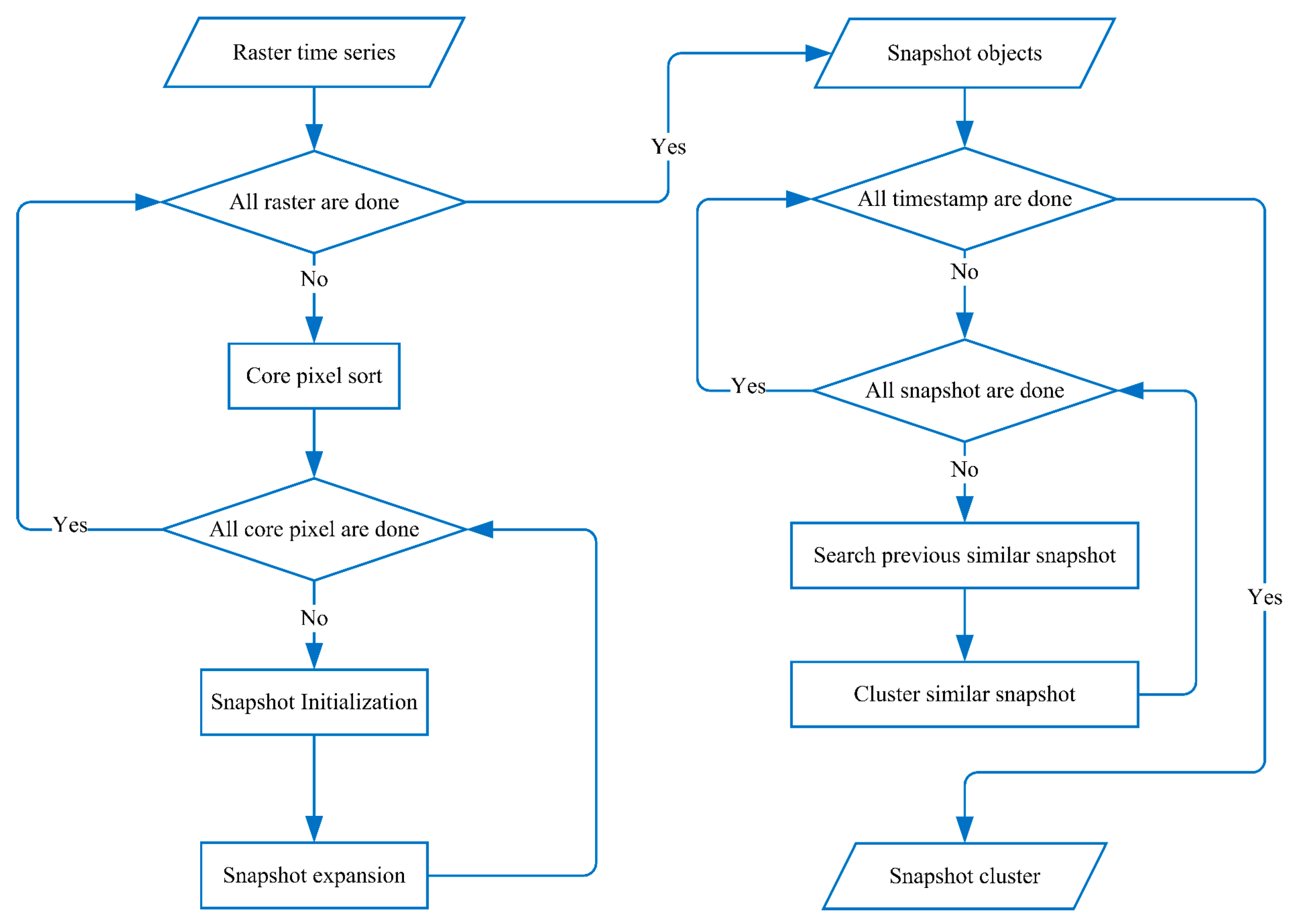

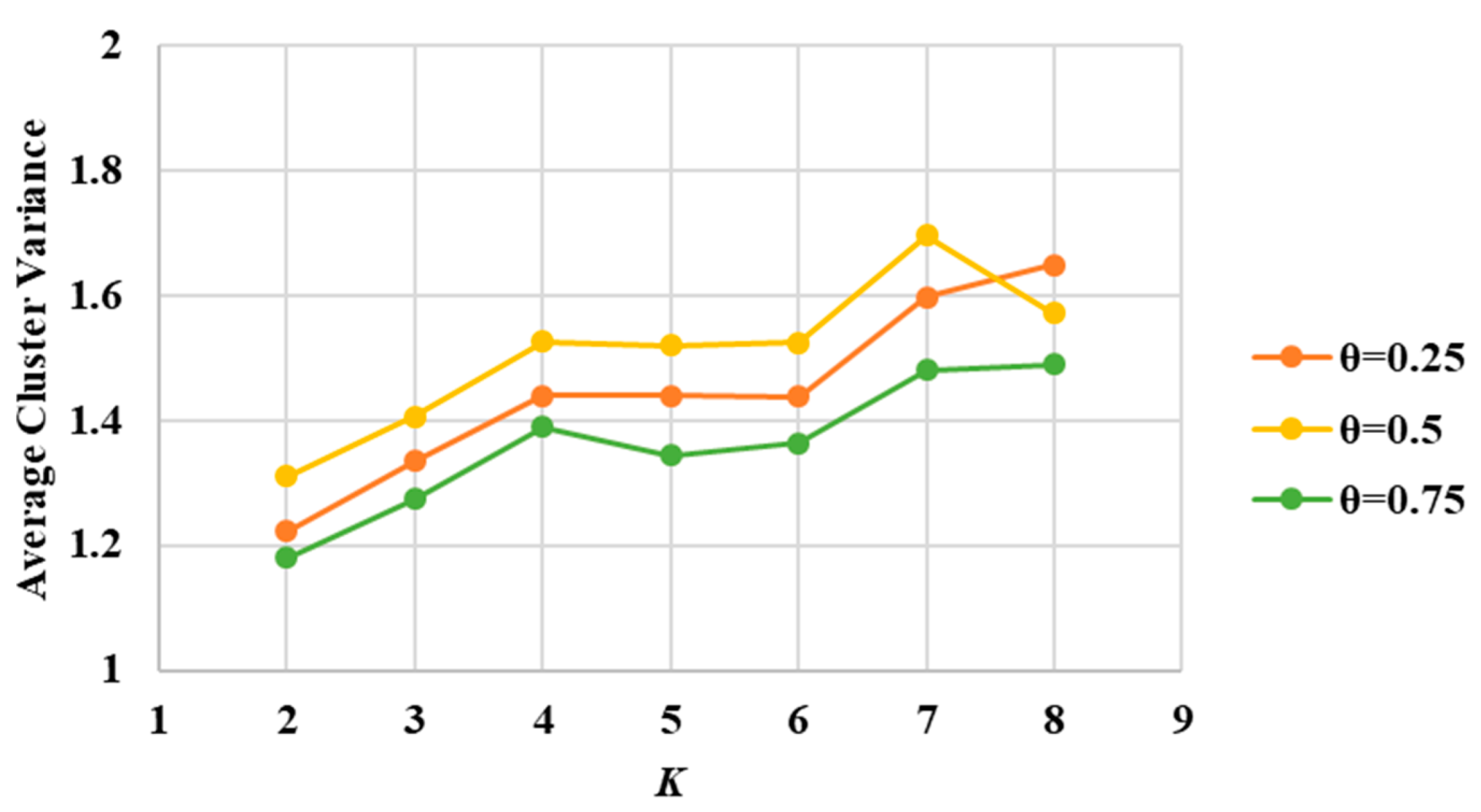
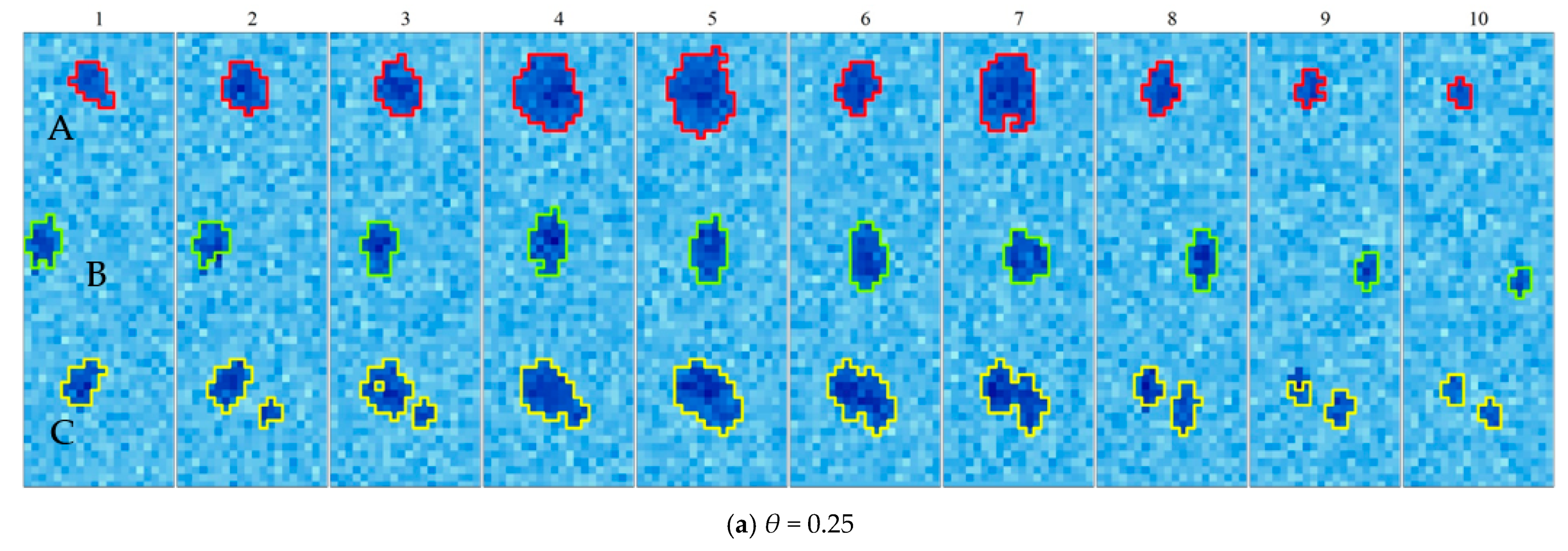

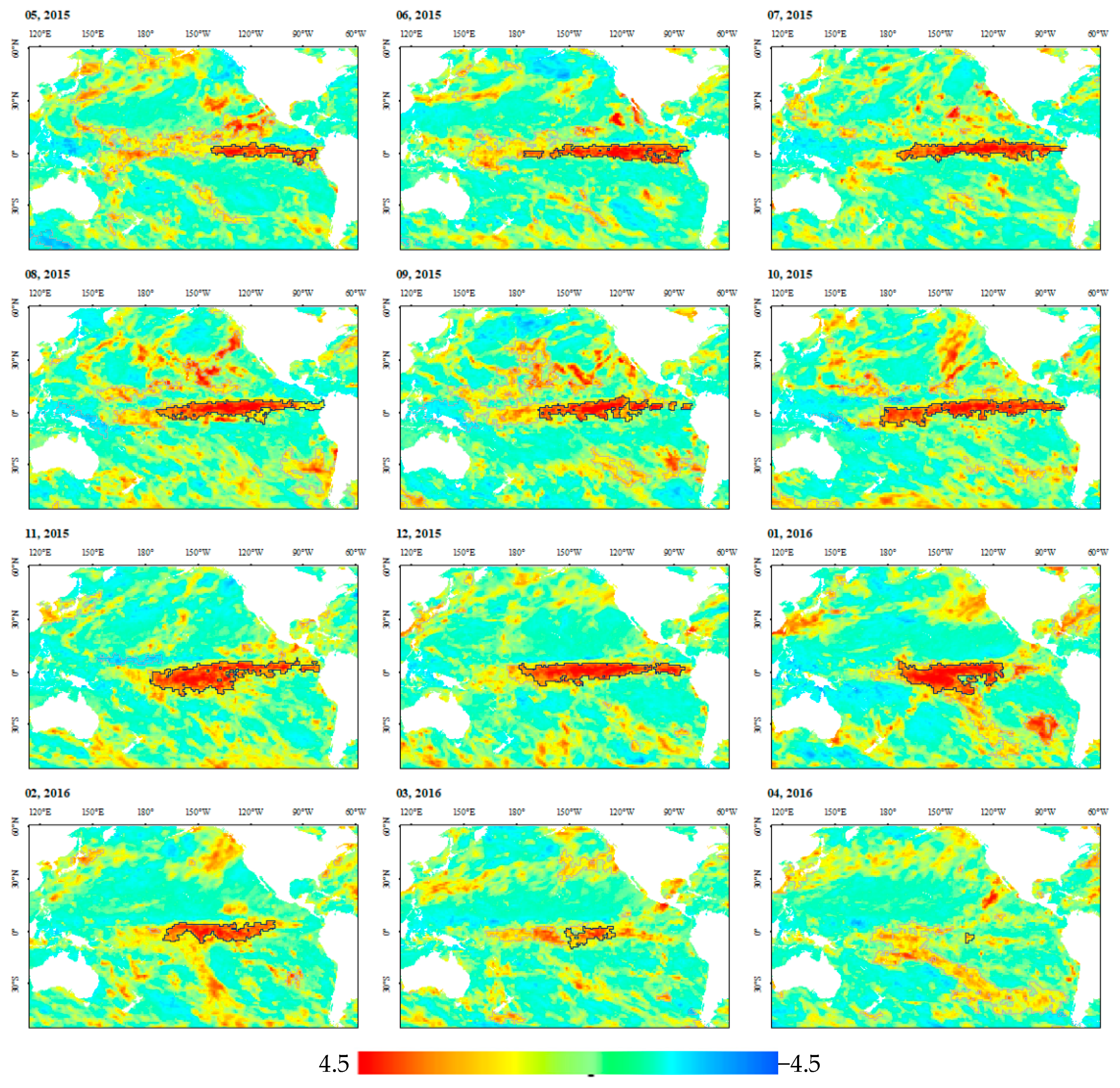
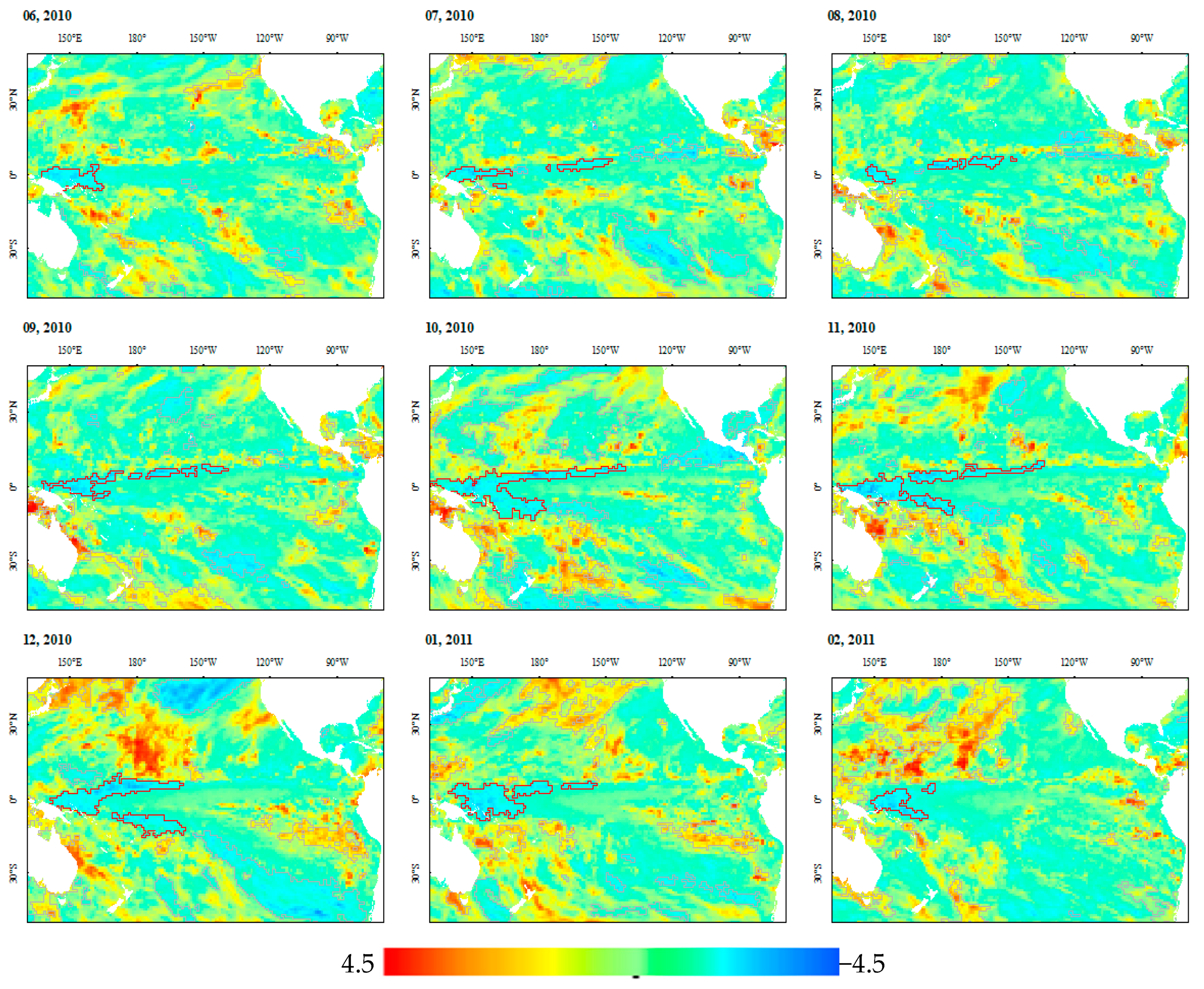

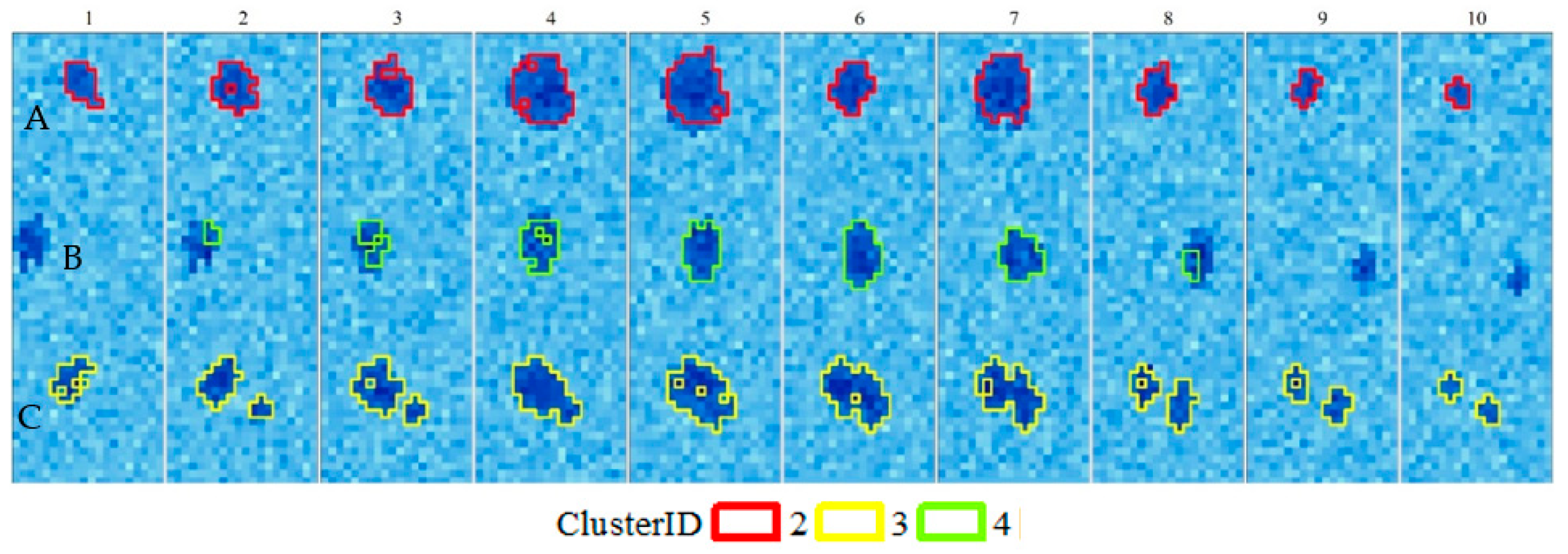
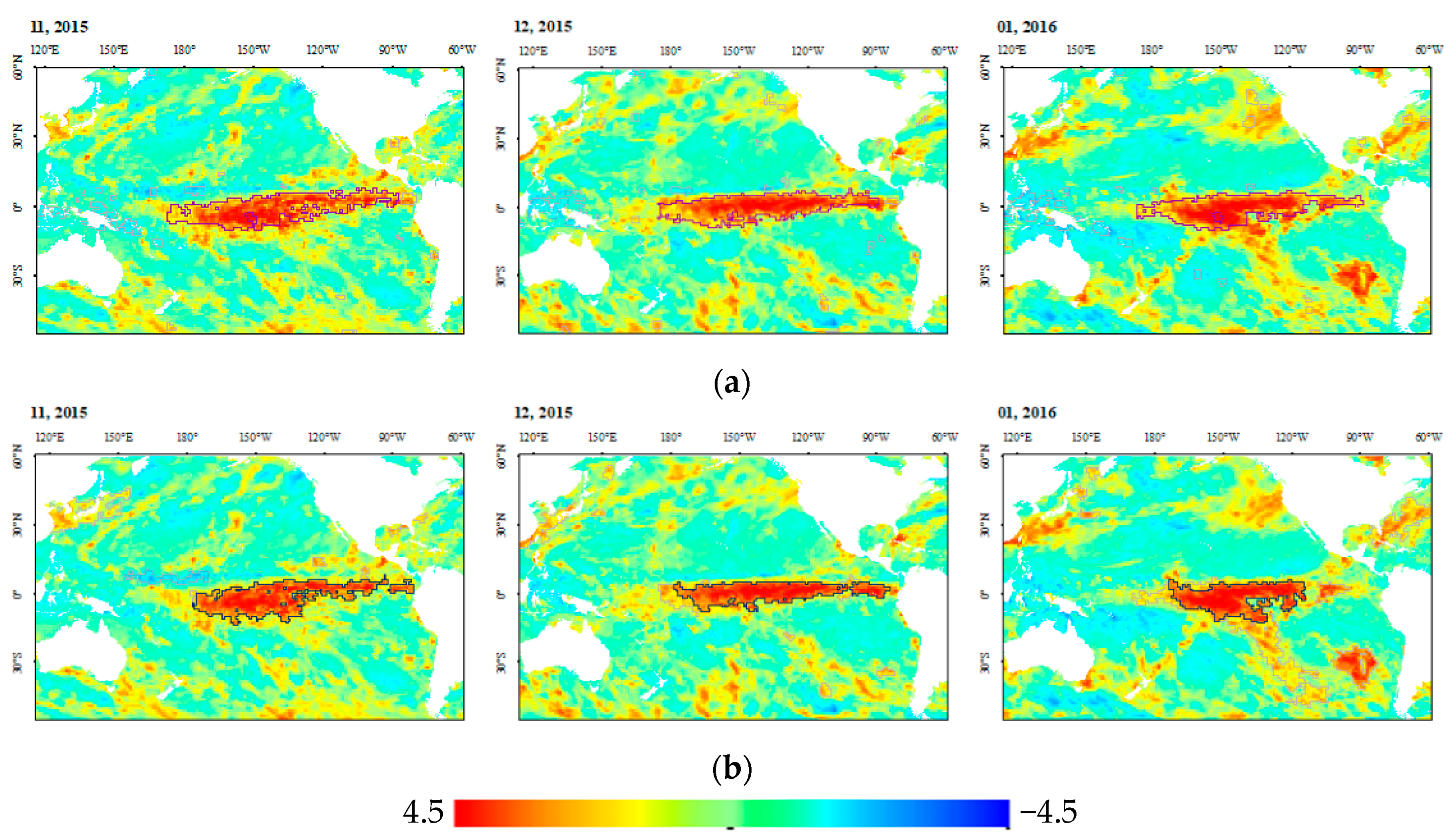

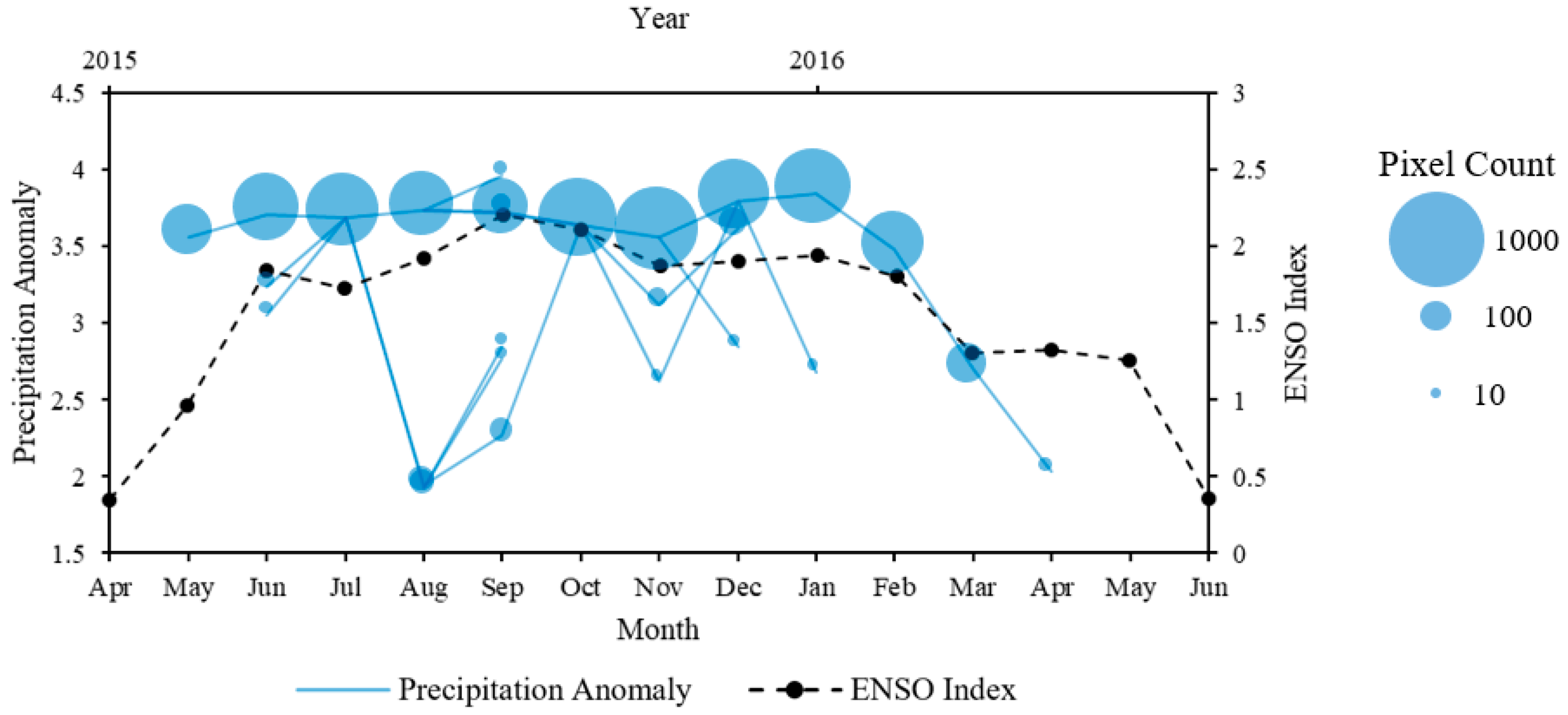
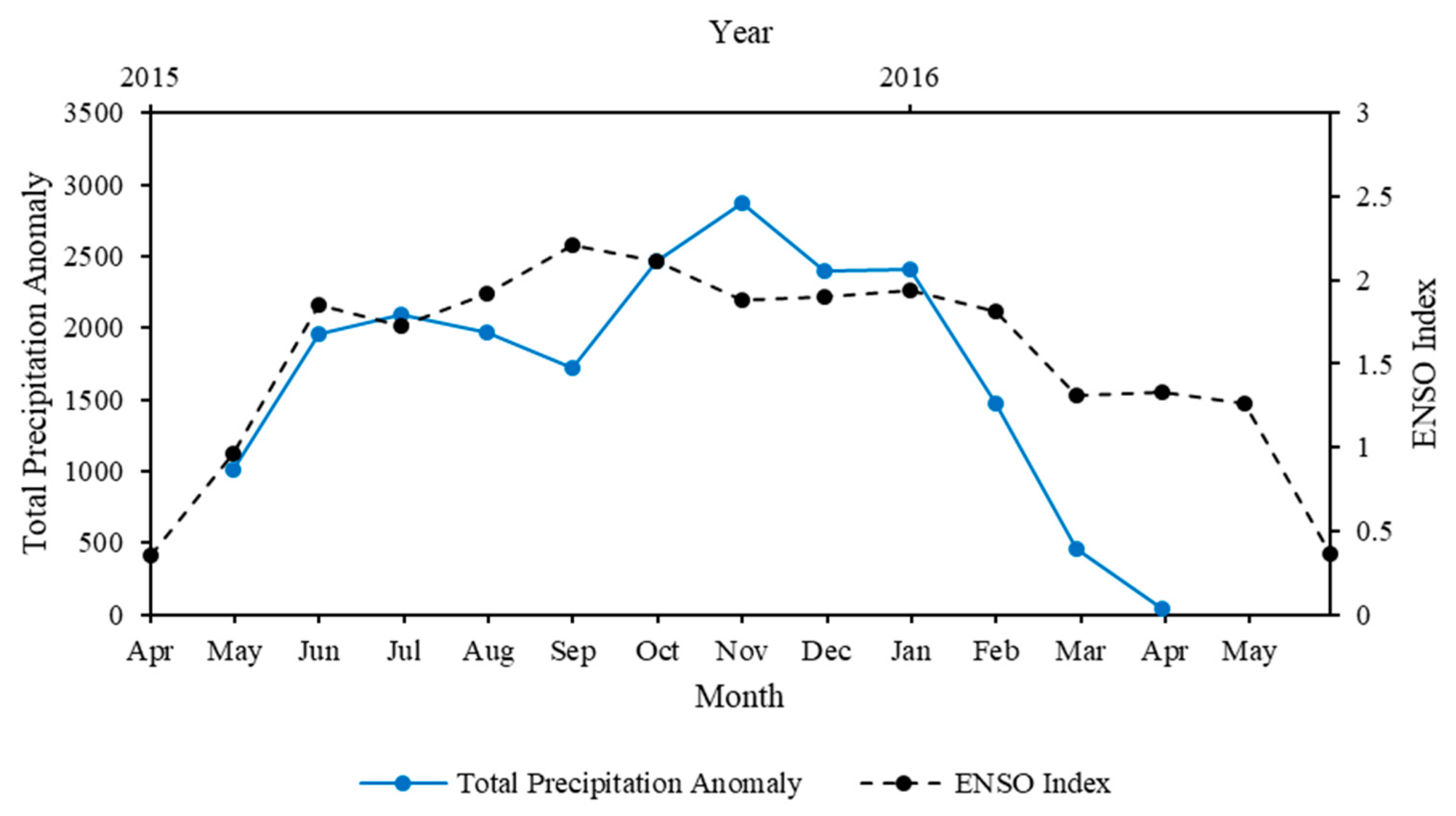
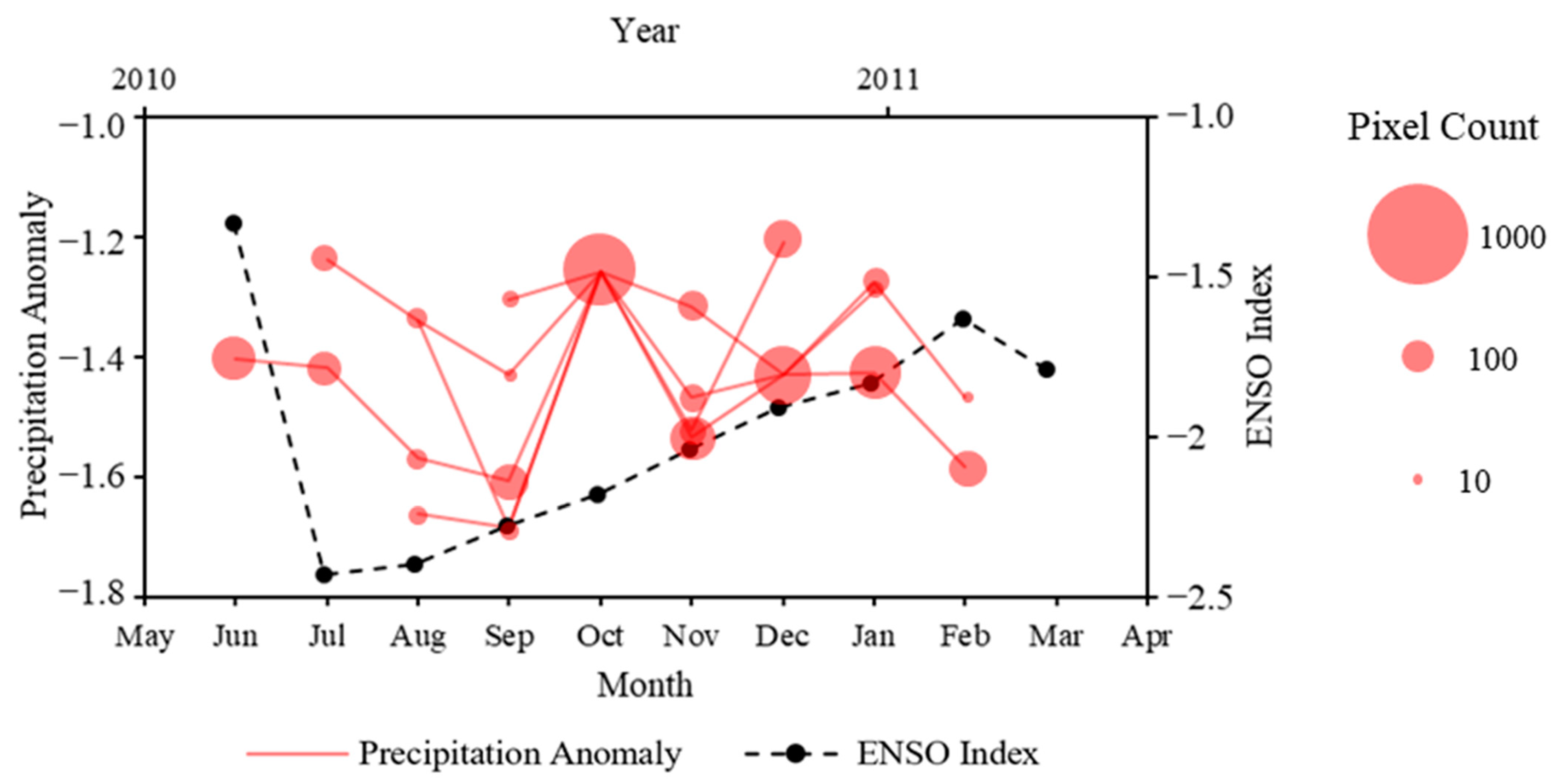

| K | Kth |
|---|---|
| 2 | 2.04 |
| 3 | 2.48 |
| 4 | 2.81 |
| 5 | 3.01 |
| 6 | 3.09 |
| 7 | 3.95 |
| 8 | 4.52 |
| Index/Algorithm | DcSTCA | OSCAR | OSCAR (θ = 0.25) | OSCAR (θ = 0.5) | OSCAR (θ = 0.75) |
|---|---|---|---|---|---|
| ARI | 0.88 | 0.95 | 0.98 | 0.98 | 0.89 |
| NMI | 0.81 | 0.91 | 0.96 | 0.94 | 0.85 |
Disclaimer/Publisher’s Note: The statements, opinions and data contained in all publications are solely those of the individual author(s) and contributor(s) and not of MDPI and/or the editor(s). MDPI and/or the editor(s) disclaim responsibility for any injury to people or property resulting from any ideas, methods, instructions or products referred to in the content. |
© 2023 by the authors. Licensee MDPI, Basel, Switzerland. This article is an open access article distributed under the terms and conditions of the Creative Commons Attribution (CC BY) license (https://creativecommons.org/licenses/by/4.0/).
Share and Cite
Li, L.; Zhang, Y.; Xue, C.; Zheng, Z. Object-Oriented Clustering Approach to Detect Evolutions of ENSO-Related Precipitation Anomalies over Tropical Pacific Using Remote Sensing Products. Remote Sens. 2023, 15, 2902. https://doi.org/10.3390/rs15112902
Li L, Zhang Y, Xue C, Zheng Z. Object-Oriented Clustering Approach to Detect Evolutions of ENSO-Related Precipitation Anomalies over Tropical Pacific Using Remote Sensing Products. Remote Sensing. 2023; 15(11):2902. https://doi.org/10.3390/rs15112902
Chicago/Turabian StyleLi, Lianwei, Yuanyu Zhang, Cunjin Xue, and Zhi Zheng. 2023. "Object-Oriented Clustering Approach to Detect Evolutions of ENSO-Related Precipitation Anomalies over Tropical Pacific Using Remote Sensing Products" Remote Sensing 15, no. 11: 2902. https://doi.org/10.3390/rs15112902
APA StyleLi, L., Zhang, Y., Xue, C., & Zheng, Z. (2023). Object-Oriented Clustering Approach to Detect Evolutions of ENSO-Related Precipitation Anomalies over Tropical Pacific Using Remote Sensing Products. Remote Sensing, 15(11), 2902. https://doi.org/10.3390/rs15112902






